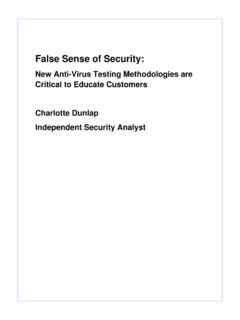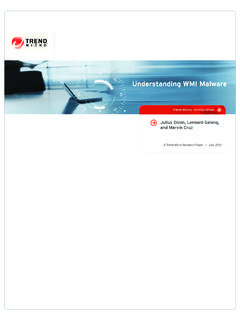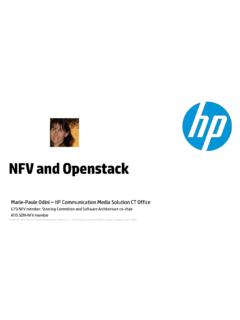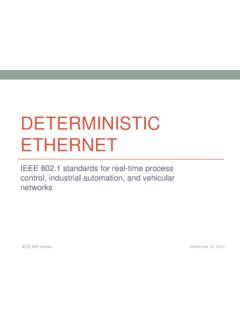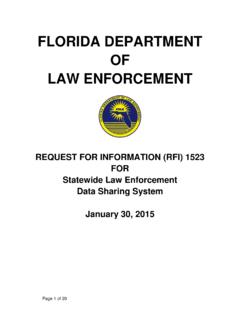Transcription of Protecting the Dynamic Datacenter - Trend Micro …
1 Trend Micro Deep Security Server Security Protecting the Dynamic Datacenter A Trend Micro White Paper | August 2009 Trend Micro DEEP SECURITY 1 White Paper | Protecting the Dynamic Datacenter I. SECURITY IN THE Dynamic Datacenter The purpose of IT security is to enable your business, not impede it, but the challenges and complexity you face for your IT security grow every day. Compliance requirements impose security standards for data and applications on servers. Physical servers are replaced with virtual machines to save money, be green, and increase scalability.
2 Cloud computing evolves the traditional IT infrastructure to increase cost savings while enhancing flexibility, capacity, and choice. Servers are no longer barricaded behind perimeter defenses, and like laptops before them, they re now moving outside the security perimeter and need a last line of defense. It s now vital to your defense-in-depth security strategy to deploy a server and application protection system delivering comprehensive security controls while supporting current and future IT environments. Trend Micro delivers answers to these challenges, including the Deep Security solution.
3 SERVERS ARE UNDER PRESSURE According to the Verizon Business Risk Team s 2008 Data Breach Investigations Report, 59% of recent data breaches were the result of hacking and intrusions. The TJX and Hannaford breaches underlined the potential for system compromises to negatively impact the reputation and operations of any business in significant ways. Organizations continue to struggle to balance the need to protect their resources with the need to extend access to those same resources to more business partners and customers. Current Payment Card Industry Data Security Standards (PCI DSS) recognize that traditional perimeter defenses are no longer sufficient to protect data from the latest threats, and that they now require multiple layers of protection beyond appliance-based firewall and intrusion detection and prevention systems (IDS/IPS).
4 Wireless networks, encrypted attacks, mobile resources, and vulnerable Web applications all contribute to the weakness that exposes enterprise servers to penetration and compromise. Within the past five years, Datacenter computing platforms, which largely had been based on physical servers, have undergone a major technology change. The traditional Datacenter footprint is shrinking to enable cost savings and greener IT through server consolidation. Nearly every organization has virtualized some or all of its Datacenter workloads, enabling multitenant uses of what previously had been single-tenant or single-purpose physical servers.
5 The Gartner Group expects that between now and 2011, the installed base of virtual machines will expand more than tenfold and it is expected that by 2012, the majority of x86 server workloads will be run within virtual machines. Trend Micro DEEP SECURITY 2 White Paper | Protecting the Dynamic Datacenter SERVERS ARE MULTIPLYING RAPIDLY AND IN MOTION The significant benefits IT virtualization offers organizations have led to widespread adoption. Virtualization increases capacity and responsiveness to corporate demands, and more efficient use of hardware and software licenses results in continued consolidation of server workloads.
6 In virtual environments, strict separation between network devices and servers diminishes these are now combined within virtualization platforms. However, since network security appliances are blind to traffic sent between virtual machines, hosting workloads of different sensitivities opens up the opportunity for attacks. Motion tools critical for managing planned downtime, effective use of virtualization resources, and application availability result in additional workload sharing on the server, impacting compliance history management and virtual security inevitable sprawl of virtual machines also increases the likelihood of exposure to malicious traffic for those without the latest patches.
7 IT personnel must closely examine the methods used to protect virtual instances of enterprise servers. SERVERS OPEN IN THE CLOUD Cloud computing extends an enterprise s ability to meet the computing demands of its everyday operations. With the growing number of organizations taking advantage of cloud computing, and service providers building public clouds, the security model is further challenged to effectively host these virtualized workloads. Security is the area that causes the greatest hesitation in organizations when it comes to moving business workloads into public clouds.
8 When IDC recently conducted a survey of 244 IT executives/CIOs and their line-of-business (LOB) colleagues to gauge their opinions and understand their companies use of IT cloud services, security ranked first as the greatest cloud computing challenge. When a server is moved to public cloud resources, the Datacenter perimeter offers no protection, as these virtualized servers now provide administrative access directly over the Internet. Problems already faced in the Datacenter , such as patch management and compliance reporting, become commensurately more complex as a result. The only relevant protection in the cloud is the lowest common denominator that the vendor can provide on its perimeter or whatever an organization can equip its virtual machine with to defend itself, since it is hosted on servers alongside other organizations workloads.
9 By far, the #1 concern about cloud services is security. With their businesses information and critical IT resources outside the firewall, customers worry about their vulnerability to attack. Frank Gens, Senior Vice President and Chief Analyst, IDC Trend Micro DEEP SECURITY 3 White Paper | Protecting the Dynamic Datacenter II. OVERVIEW: Trend Micro DEEP SECURITY The Trend Micro Deep Security solution is server and application protection software that unifies security across virtual, cloud computing, and traditional Datacenter environments. It helps organizations prevent data breaches and business disruptions, enable compliance with key regulations and standards including PCI, and help reduce operational costs as the current economic climate requires.
10 The Deep Security solution enables systems to become self-defending and is optimized to help protect your confidential data and ensure application availability. The Deep Security solution provides comprehensive protection, including: Deep packet inspection enabling Intrusion detection and prevention (IDS/IPS), web application protection, and application control Stateful firewall File and system integrity monitoring Log inspection III. COMPREHENSIVE, MANAGEABLE SECURITY The Deep Security solution uses modules to address key server and application protection requirements.


